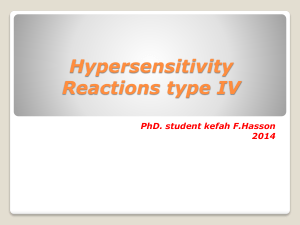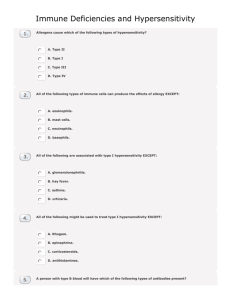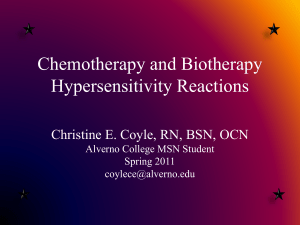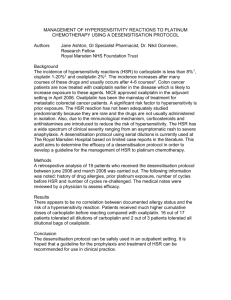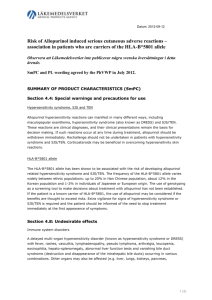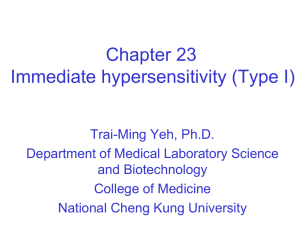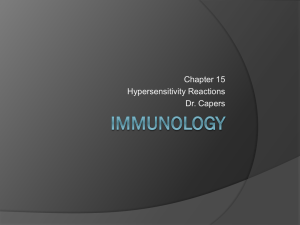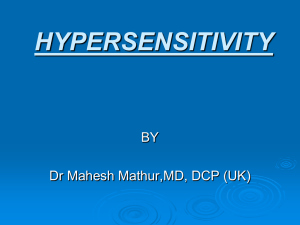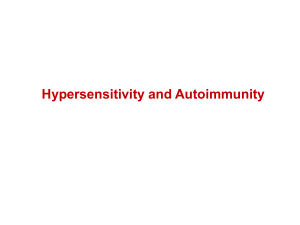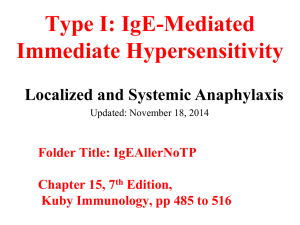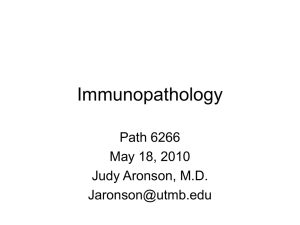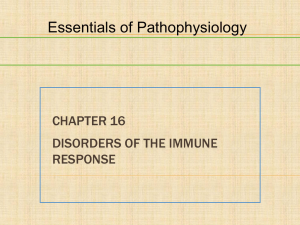Hypersensitivity
advertisement
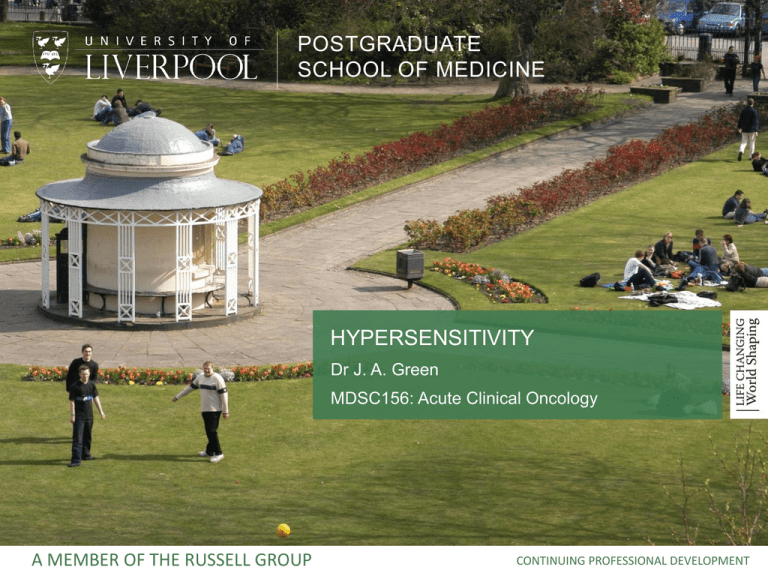
POSTGRADUATE SCHOOL OF MEDICINE HYPERSENSITIVITY Dr J. A. Green MDSC156: Acute Clinical Oncology A MEMBER OF THE RUSSELL GROUP CONTINUING PROFESSIONAL DEVELOPMENT Hypersensitivity 2 Aims • To define types of hypersensitivity reaction (HSR) • Identify which anticancer agents are most likely to provoke a HSR • Which interventions can be used to reduce risk of HSR • When is it safe to rechallenge? Hypersensitivity 3 Defining Hypersensitivity • An exaggerated immune response that results in tissue injury or changes throughout the body in response to an antigen or foreign substance (Gobel, 2005). • Most reactions to standard chemotherapy agents are consistent with type 1 hypersensitivity; • Anaphylaxis reaction (IgE mediated) occurs with prior exposure • Anaphylactoid (non IgE mediated) occurs without prior exposure Hypersensitivity Immunologic Mechanism 4 Hypersensitivity 5 Cytokine Release Syndrome • Cytokine-release syndrome (CRS) can present almost the same as type I (IgE) reaction and develop into an anaphylaxis type reaction. • CRS is related to changes of serum cytokine levels due to rapid injection of an antibody (Hrishikesh & Pashtoon, 2012). • CRS caused by release of cytokines can cause: • Fever • Dyspnea • Chills • Hypotension • Nausea • Tachycardia • Rash Hypersensitivity 6 Mechanisms of CRS Monoclonal Antibody Cancer Cell Immune effector cells Compliment Cancer Cell Breslin, 2007 Cytokines release into blood stream Cell Death Hypersensitivity 7 High Risk Antineoplastics Antineoplastic drugs with a high probability of initiating an HSR include: • • • • • Monoclonal antibodies Taxanes Platinum compounds Asparaginase Liposomal preparations (Kuntzsch & Vogue, 2009) Hypersensitivity 8 Premedication Premedication is required to help prevent/reduce severity of HSRs and can include; • Histamine-2 (H2) receptor antagonists • Ranitidine or Cimetidine • Corticosteriods • Dexamethasone • Histamine-1 (H1) receptor antagonists • Chlorphenmine Hypersensitivity Treatment in HSR • • Primary treatment is prevention • History taking patient previous allergy • Nursing knowledge of high risk agents, appropriate premedication • Monitor patient for signs of HSR Suspected HSR • Stop anticancer agent, maintain IV fluids, inform medical staff • Emergency equipment & medication at hand • Continue to monitor vital signs • Administer emergency drugs & oxygen according to guidelines • Document incident and reaction grade 9 Hypersensitivity 10 Hypersensitivity 11 Rechallenge • Most patients who experience mild-moderate reaction (grade 1-2) during 1st exposure i.e. taxanes and monoclonal antibodies, will tolerate rechallenged using slower infusion rate and premedication. • Rechallening platinum agents is generally less successful than with taxanes, 50% experience recurrent HSR despite premedication. • Desensitization protocols modifying infusion times have been successful at reducing 2nd reactions. • Rechallenge is discouraged in severe initial reactions (grade 3-4). • In all cases decision to rechallenge should be based on RISK v BENEFIT highlighting the need for accurate grading of HSR and CRSs. (Lenz HJ 2007) Hypersensitivity 12 References • Breslin S (2007) Cytokine reaction syndrome: overview and nursing implications. Clinical Journal of Oncology 11, 1, 37-41. • Gobel Holmes B (2005) Chemotherapy-Induced Hypersensitivity Reaction. Oncology Nursing Forum 32, 5, 10271035 • Gonzalez et al (2000) Hypersensitivity reactions to chemotherapy. Alergol Immunol Clin. 15, 161-181. • Hrishikesh SK & Pashtoon MK (2012) Rituximab and Cytokine Release Syndrome. Case Reports Oncology 5, 1, 134-141. • Kuntzsch T & Vogue CA (2009) Hypersensitivity Reactions to Chemotherapy. In Chernecky C & Murphy-Ende K (Eds) Acute Care Oncology Nursing 2nd Ed. Elsevier, Missouri, USA. • Lenz HJ (2007) Management and Preparedness for Infusion and Hypersensivity reactions. The Oncologist 12, 601-609. • National Cancer Institute (NCI) (2007) Common Toxicity Criteria version 3. • Vogel WH (2010) Infusion reactions: diagnosis, assessment and management. Clinical Journal of Oncology 14, 2, E10-E21. • Cheng et al (2014) HLA associations and clinical implications in T-cell mediated drug hypersensitivity reactions: an updated review, J. Immunol Res. ;2014:565320. doi: 10.1155/2014/565320. FACULTY OF HEALTH & LIFE SCIENCES – CPD Institute for Learning & Teaching Faculty of Health & Life Sciences Room 2.16A, 4th Floor Thompson Yates Building Brownlow Hill Liverpool L69 3GB www.liv.ac.uk/learning-and-teaching/cpd A MEMBER OF THE RUSSELL GROUP
